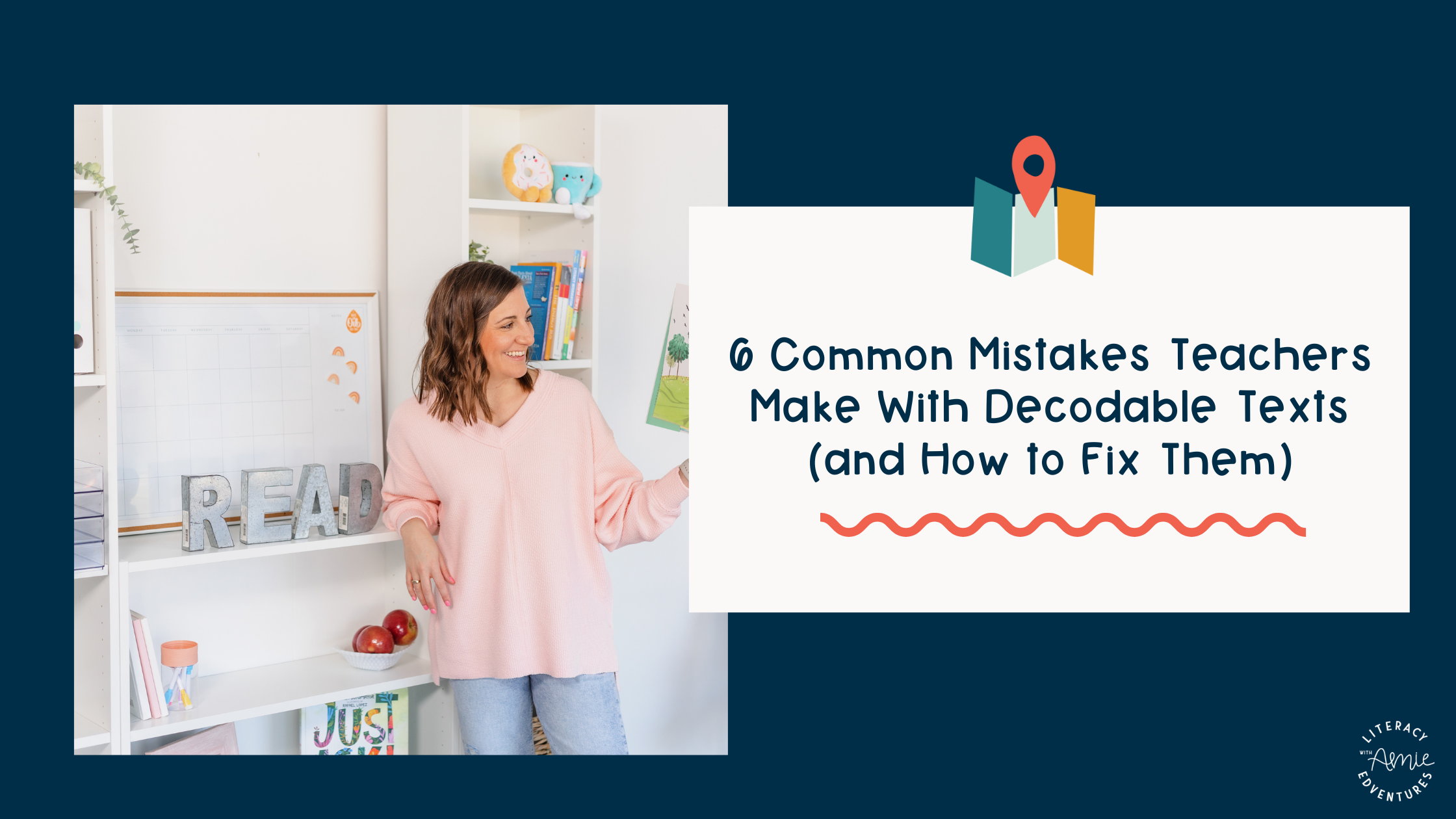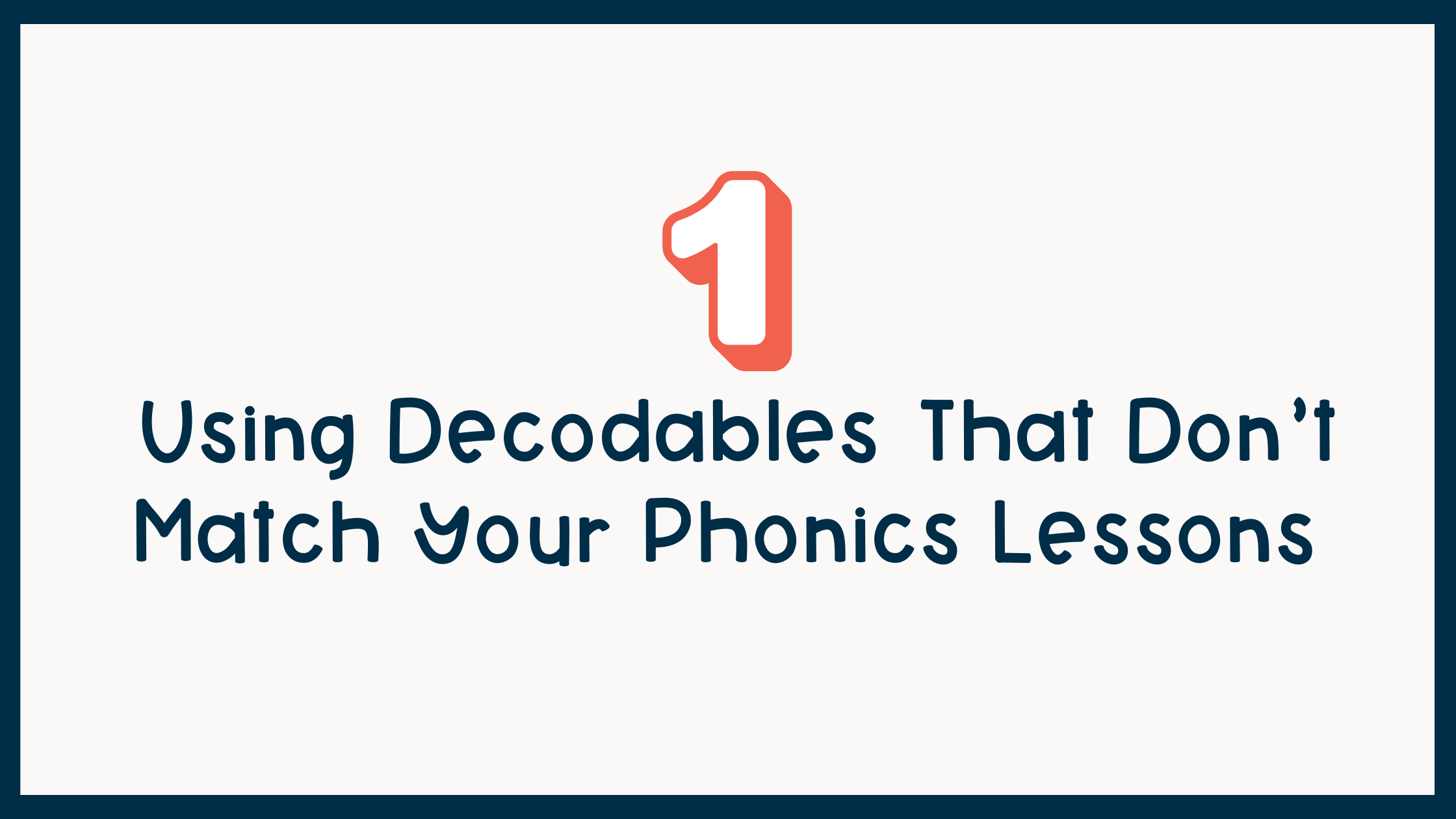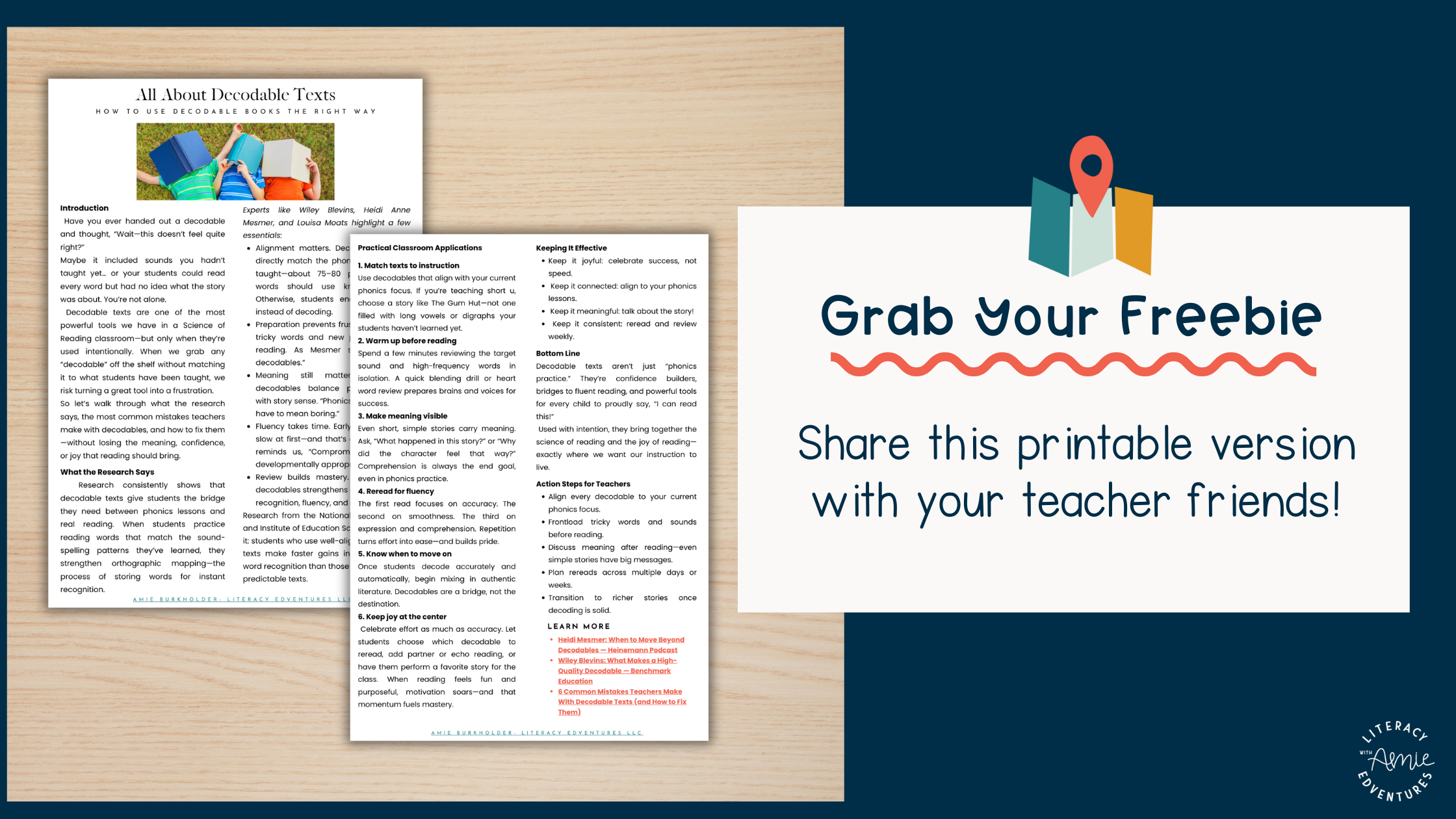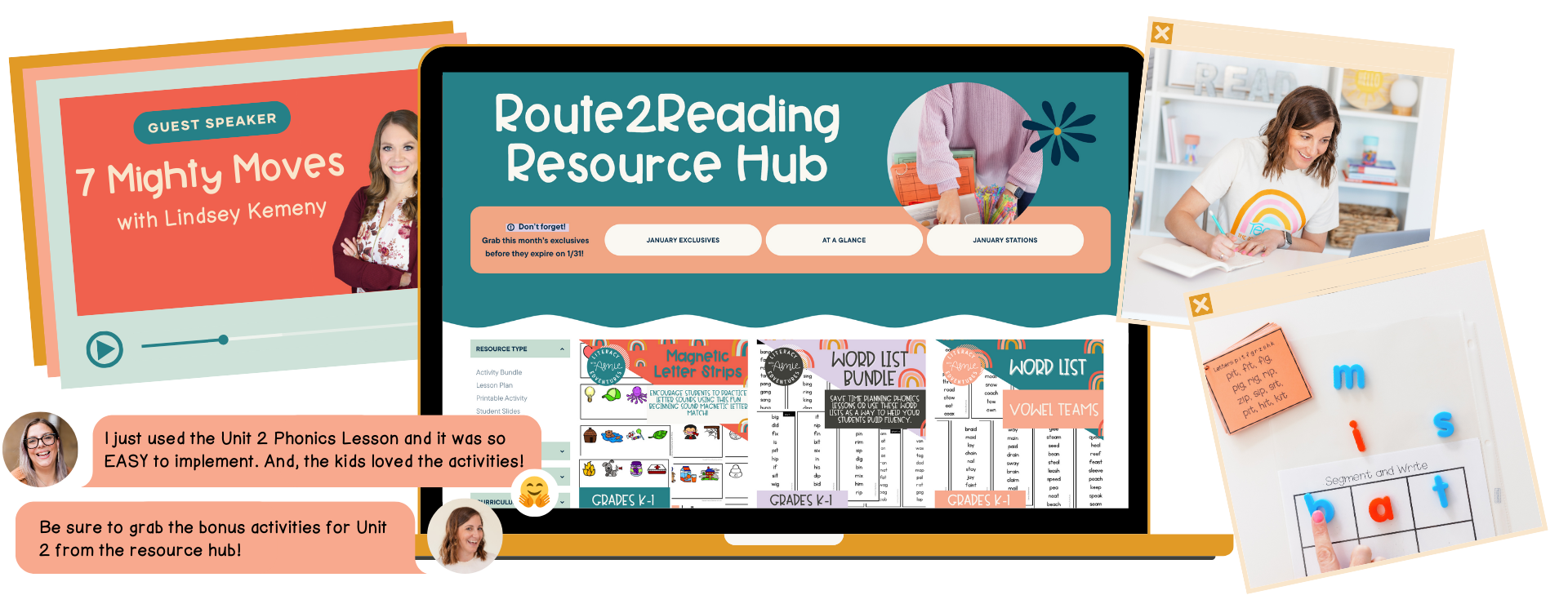6 Common Mistakes Teachers Make With Decodable Texts (and How to Fix Them)
How to use decodable books the right way—without losing meaning, confidence, or joy.
Introduction
Have you ever handed your students a decodable book and instantly thought… “Wait, why is this so hard for them?”They’re sounding out every word, but it feels slow. The story doesn’t quite match what you’ve been teaching. Or maybe the book is so controlled it sounds robotic — “Sam sat. Pam sat.”
If you’ve been there, you’re in good company. Every K–2 teacher who’s embraced the Science of Reading has probably had that same moment. Decodable texts are powerful — they help kids apply phonics in real reading. But using them well takes a little more intentionality than just pulling “the next book in the bin.” Experts like Wiley Blevins and Heidi Anne Mesmer have shown us that how we choose and use these books can make or break the reading experience for kids.
So today, we’re digging into six of the most common mistakes teachers make with decodable texts — and how to fix them. You’ll walk away with simple, practical tweaks that help your students read with more meaning, confidence, and joy.
1. Using Decodables That Don’t Match Your Phonics Lessons
We’ve all done it. You finish teaching short a words, grab a decodable labeled “Level 1,” and dive in — only to find sh, ch, and long vowels sprinkled throughout. Cue the frustrated faces.
That’s misalignment. The book isn’t actually decodable for your students yet.
Heidi Mesmer says it best: “If you haven’t taught the pattern, the book won’t teach it for you.”
The fix: Choose decodables that line up with your phonics scope and sequence. Look for books that are 75–80% decodable based on what you’ve already taught, with just a few high-frequency words added in for natural flow.
When the content matches instruction, students get that “I can read this!” moment — and that’s where confidence grows.
2. Jumping Into a “Cold Read”
Picture this: It’s right after lunch, you hand out a new decodable, and say, “Let’s read!”
The first sentence takes forever. Students hit words like said or game and freeze.
The problem? No warm-up.
The fix: Take 2–3 minutes to prep before reading.
Review the target sound (for short u, maybe sun, cup, bug).
Introduce tricky words like said or come ahead of time.
Do a quick “word warm-up” — a few practice words they’ll see in the text.
Think of it like stretching before a workout. A quick pre-teach sets kids up for smoother, more successful reading.
3. Treating Decodables Like Word Lists Instead of Stories
We’ve all powered through a decodable like it’s a decoding drill: “Tim sat. Pam ran. The end.”
But if we never talk about what’s happening in the story, students miss the point — reading is about making meaning.
The fix: Pick decodables with actual plots and take time to discuss them.
Do a short “book walk” to preview pictures and words.
Talk about new vocabulary (“Lug means to carry something heavy — have you ever had to lug your backpack?”).
Ask simple comprehension questions: “Why was Pam mad at Tim?”
Even simple decodables can (and should) feel like real books. When kids see stories instead of drills, their engagement skyrockets.
4. Expecting Fluency Too Soon
When a beginning reader slowly sounds out s-u-n… sun, it’s tempting to say, “Try to read faster.” But slow and steady decoding is exactly what they should be doing right now.
This is what Jeanne Chall called the “glued to the print” stage — where accuracy matters more than speed.
The fix: Celebrate accurate decoding, even if it’s slow. Then build fluency through rereading.
First read: slow and careful.
Second read: choral or partner read.
Third read: confidence read — let them show off!
With each reread, the brain recognizes patterns more automatically. That’s how fluency really grows.
5. Reading Once and Moving On
We’ve all been guilty of the “one-and-done” approach — teach the skill, read the decodable, then shelve it. But mastery comes from review and repetition.
Wiley Blevins reminds us that “teach it and leave it” is one of the biggest gaps in phonics instruction.
The fix: Bring back old decodables weekly.
Reread a story from 2–3 weeks ago.
Use them in literacy stations or send them home for practice.
Celebrate rereading as a sign of growth (“Wow, you read that so much faster this time!”).
Kids love revisiting texts they’ve mastered — it’s a huge confidence booster.
6. Using Decodables for Too Long (or Not Long Enough)
This one’s all about timing. Some teachers move away from decodables too early; others hang on too long. Both can hold students back.
The fix: Use decodables while students are still learning to blend and decode one-syllable words accurately. Once they can read those smoothly and automatically, start mixing in more authentic texts.
Heidi Mesmer suggests this decoding stage typically lasts about 2–3 months for most students. Some will need longer, and that’s okay. The key is to watch for readiness — when students are confident and accurate, it’s time to widen their reading diet.
The Big Takeaway
Decodable texts are one of our most powerful tools for early reading success — when we use them well.
Here’s the bottom line:
-Match books to what you’ve taught.
-Warm up before reading.
-Talk about the story, not just the sounds.
-Celebrate accuracy before fluency.
-Reread and review.
-Move on when kids are ready.
When used intentionally, decodable books don’t just build decoding skills — they build joyful, confident readers.
So next time you hand out a decodable, pause and ask yourself:
-Does this text truly match what I’ve taught?
-Have I prepped my students for success?
-Am I helping them see this as real reading?
Small shifts like these can make a huge difference — turning decodables from “another routine” into a moment where students proudly say, “I can read this all by myself!”
Wish you had a literacy coach and resources in your back pocket?
I understand that buying each resource separately can quickly ADD UP. As a teacher, I know we have to make the money we spend COUNT! But don’t worry—there’s a more straightforward, more efficient solution with Route2Reading, my K-2 membership designed to streamline planning, prepping, and teaching small group instruction. Rather than spending your weekends glued to your computer, searching for Science of Reading-aligned phonemic awareness, phonics lessons, and decodable texts for your small groups, you can log in to Route2Reading. Choose the focus skill for the week, download the detailed, step-by-step lesson plans and activities, and your small group instruction is ready to go in just a few clicks. Planning has never been easier!
I hope that you found today’s post helpful. Whether you choose to join the membership or not, I am always here to help you in any way that I can. Leave your questions below or send me an email Amie@literacyedventures.com














